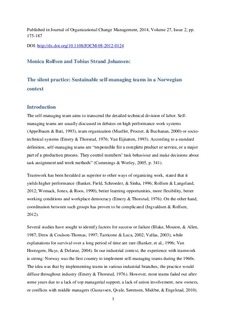| dc.contributor.author | Rolfsen, Monica | |
| dc.contributor.author | Johansen, Tobias Strand | |
| dc.date.accessioned | 2017-12-21T07:55:02Z | |
| dc.date.available | 2017-12-21T07:55:02Z | |
| dc.date.created | 2014-04-30T08:51:04Z | |
| dc.date.issued | 2014 | |
| dc.identifier.citation | Journal of Organizational Change Management. 2014, 27 (2), 175-187. | nb_NO |
| dc.identifier.issn | 0953-4814 | |
| dc.identifier.uri | http://hdl.handle.net/11250/2473372 | |
| dc.description.abstract | Purpose - The purpose is to provide explanations for why some self-managing teams survive and develop over a long period of time. Design/methodology/approach - The research design is longitudinal, having worked with several research projects over a period of 20 years. Interviews, observation, field notes have been widely used, and also participative methods while one of the authors has worked on the shop floor for six weeks. Findings - We offer several explanations; the maturity of teams; the process of institutionalization and creation of strong normative values, practices being "infused with meaning" and decoupling of practice from official policy. Research limitations/implications - The weakness is that the research presented is from one company, and within a Norwegian context which has certain characteristics. The contribution is the emphasis on institutional elements and the methodological implications regarding informal practice where explicit information is incomplete. Practical implications - By offering an explanation for why self-managing teams can survive, one can also prescribe some important learning. Mutual cooperation and high level of autonomy prove to be important. Originality/value - The main contribution is our access to unique empirical data, and that we show and explain the social mechanisms for institutionalization of teamwork through participative observation. | nb_NO |
| dc.language.iso | eng | nb_NO |
| dc.publisher | Emerald | nb_NO |
| dc.title | The silent practice: Sustainable self-managing teams in a Norwegian context | nb_NO |
| dc.type | Journal article | nb_NO |
| dc.type | Peer reviewed | nb_NO |
| dc.description.version | acceptedVersion | nb_NO |
| dc.source.pagenumber | 175-187 | nb_NO |
| dc.source.volume | 27 | nb_NO |
| dc.source.journal | Journal of Organizational Change Management | nb_NO |
| dc.source.issue | 2 | nb_NO |
| dc.identifier.doi | 10.1108/JOCM-08-2012-0124 | |
| dc.identifier.cristin | 1130635 | |
| dc.relation.project | Norges forskningsråd: 210671 | nb_NO |
| dc.description.localcode | © 2014. This is the authors' accepted and refereed manuscript to the article. The final authenticated version is available online at: http://www.emeraldinsight.com/doi/full/10.1108/JOCM-08-2012-0124 | nb_NO |
| cristin.unitcode | 194,60,25,0 | |
| cristin.unitname | Institutt for industriell økonomi og teknologiledelse | |
| cristin.ispublished | true | |
| cristin.fulltext | postprint | |
| cristin.qualitycode | 1 | |
